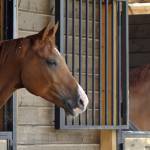Stereotypies and Tools for Feeding Horses

Approximately 12% of companion horses and up to 24% of racing Thoroughbreds have stereotypies—repetitive, invariant behaviors with no apparent function.
Several factors contribute to the development of stereotypies, including number of hours spent in a stall per day, grazing opportunities, frequency of being fed hay, and inability to touch other horses. Typical examples of stereotypical behaviors include stall-walking, weaving, and crib-biting. All of these are indicators of reduced equine welfare.
Various commercially available environmental enrichment tools are available, including food puzzles. Such products are designed to encourage foraging behavior in stall-bound horses. Shopping for such products, however, leaves some wondering what the best product is and whether or not feeding tools are a worthwhile expenditure.
“Research regarding the efficacy of feeding tools in either the mitigation or avoidance of stereotypies is scarce, but certainly important, especially considering the number of horses that are housed individually for prolonged periods of time,” said Kathleen Crandell, Ph.D., equine nutritionist at Kentucky Equine Research (KER).
She added, “Horses evolved to survive on a high-fiber, low-starch diet consumed by grazing for 14-16 hours of every day. Deviation from that diet, which is based on forage, can lead not only to stereotypies but also hindgut acidosis, gastric ulcers, and laminitis.”
A group of Canadian researchers* recently tested a feeding tool in four horses with stereotypic behavior (two weavers, two cribbers). The tool was a tongue-activated food dispenser that was filled with a liter of water with corn syrup and a flavoring agent. In this small study, no difference in either frequency or duration of stereotypic behavior was found, but the authors noted that “data trended toward a treatment effect depending on the day.”
In addition, the study authors indicated other studies that showed a positive influence of feeding strategies and puzzles on equine stereotypies, including the following:
- Providing free-choice hay to stalled horses does not affect cribbing behavior in confirmed cribbers but could prevent the behavior from developing;
- Tongue-activated dispensers might be more valuable if filled with a source of fiber instead of a liquid;
- An alternate feeding puzzle in the shape of a ball that contains a food reward significantly reduced stereotypic behavior;
- Enrichment tools with a food reward are used more frequently than nonfood-related products; and
- The best prevention for stereotypic behavior is providing ample grazing opportunities to young horses, such as foals, weanlings, and yearlings.
*Stanley, S.O., J.P. Cant, and V.R. Osborne. 2015. A pilot study to determine whether a tongue-activated liquid dispenser would mitigate abnormal behavior in pasture-restricted horses. Journal of Equine Veterinary Science 35:973-976.








